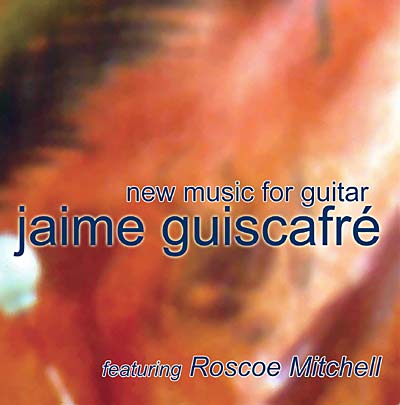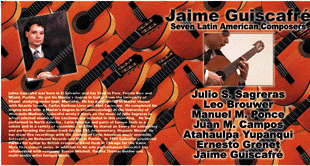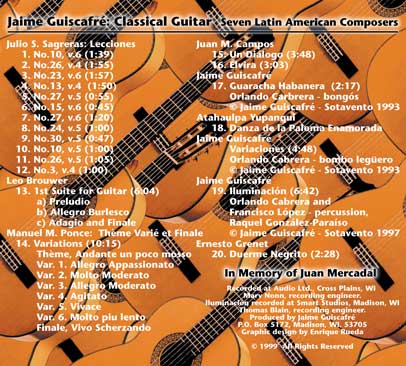New Music for Guitar
(Click here for a sound sample)

Musicians
Jaime Guiscafré, guitar
Roscoe Mitchell, flute
Joe Caploe, percussion, vibes
Jeffry Eckels, bass
Jamie V. Ryan, percussion, drums
|
Merengue
and Preludio Brasileño are from the Suite Caribeño.
These are a suite of solo guitar pieces that I composed using
the unique Afro-Latin music of the Caribbean and the northeast
coast of Brazil. The three ensemble pieces, La Pobrecita, De
Nada de Nadie and Dolores are portraits of people dear to me.
The first two are Brazilian Jazz sambas. Dolores is a bossa nova
dedicated to the memory of my mother.
The other solo guitar pieces are from a diverse group of distinguished
composers and musical genres. Piccola Arietta no. 1 by Hawaiian
composer Byron Yasui is a short, poignant lyrical piece emulating
an aria. It contains, among other things, a rare use of double
harmonics on the guitar. Doina, by Amy Dunker uses a Jewish klezmer
musical form, and has a quasi-improvisational feel. Rapsodía by William Ortiz
paints an urban soundscape reflecting Ortíz’ upbringing
as a Puerto Rican living in NYC.
•To obtain recordings of Jaime Guiscafre contact
NEXTAGEM Records, http://www.buyacdfromus.com
The Orchard http://www.theorchard.com
Lutherie Music Corp., http://www.luthiermusic.com
Apple iTunes Music Store
|
|
This recording presents little known guitar worksof several Latin
American composers, including Leo Brouwer, Juan Campos, Jaime Guiscafre,
Manuel Ponce, A. Yupanqui, Ernesto Grenet and Julio Sagreras, ranging
from Cuba, Puerto Rico, Mexico, Brazil and Argentina.
Julio Salvador Sagreras (1887-1942) is known chiefly for his six
volume set of graded etudes, Lecciones de Guitarra, which are internationally
acclaimed for their sophistication and beauty. Sagreras's short
pieces incorporate diverse musical influences from Latin America
and Europe, including European historical styles and Argentine musical
forms such as the zamba, estilo and vals.
Leo Brouwer's (1933-) First Suite for Guitar (unpublished) is a
three movemnet work of contrasting moods and tempos. The Prelude
begins with an undulating bass line with rich harmony accompanying
a simple melody. Allegro Burlesco is perhaps more evocative of a
mid-twentieth century European neo-romantic idiom while being an
exciting virtuosic piece for guitar. The suite concludes with an
Adagio Finale, a return to a Cuban-influenced lullaby along with
a recapitulation to the first movement Prelude.
Manuel M. Ponce (1882-1948) was among the first Mexican composers
to achieve international acclaim during the twentieth century. His
tightly composed Thème Varié et Finale is a set of
lyrical and rhythmic variations based on a short theme which culminates
in the finale, cleverly comprised of all the previous variations.
The Puerto Rican Danza is derived from the Cuban contra-danza habanera
at the beginning of the nineteenth century. The Puerto Rican form
developed by the 1850s. The Danza is comprised of two sections:
a paseo, or short introduction of varying mood, then a merengue
or primary section which goes to a trio and recapitulates to the
merengue.
Juan Morel Campos (1857-1896) was a major composer during the late
1800s in Puerto Rico. He composed many Danzas for the piano. Two
of these, Un Diálogo and Elvira were transcribed by guitarist
Leonardo Egurbida.
Danza de Paloma Enarmorada is an Argentine chacarera composed by
Atahualpa Yupanqui (1926- ). Despite its brevity it displays quite
an array of guitaristic effects. A set of variations composed by
Guiscafré based on the chacarera rhythm follows the danza
on guitar and the bombo legüero (Andean double-membraned drum).
Guaracha Habanera is a fusion of two Afro-Caribbean song forms,
the Guaracha and the Habanera. Guiscafré combined the two
forms by setting the theme to a Habanera rhythm while the accompaniment
supports the melody in a Guaracha rhythm. The bongós embellish
the guitar and Cabrera plays a short bongó solo during the
middle section.
Guiscafré’s Iluminación is a two part piece
for violin, guitar and percussion. The first section is a Brazilian
Samba in allegro tempo which concludes with rapid scales played
in unison by the violin and guitar. The last section is a Bossa
Nova, featuring a languid violin solo with a syncopated guitar accompaniment.
The ending is a return to the original chord progression, yet it
is masked with a slow tempo and a descending bass line.
Duerme Negrito, composed by Ernesto Grenet of Cuba, is based on
traditional Afro-Cuban lullabies. Leo Brouwer arranged it for solo
guitar, creatively using pizzicato effects on the low strings of
the instrument, mimicking the sound of pitched drums.
This CD was dedicated to the memory of Juan Mercadal
Produced by Jaime Guiscafré |
|
|



